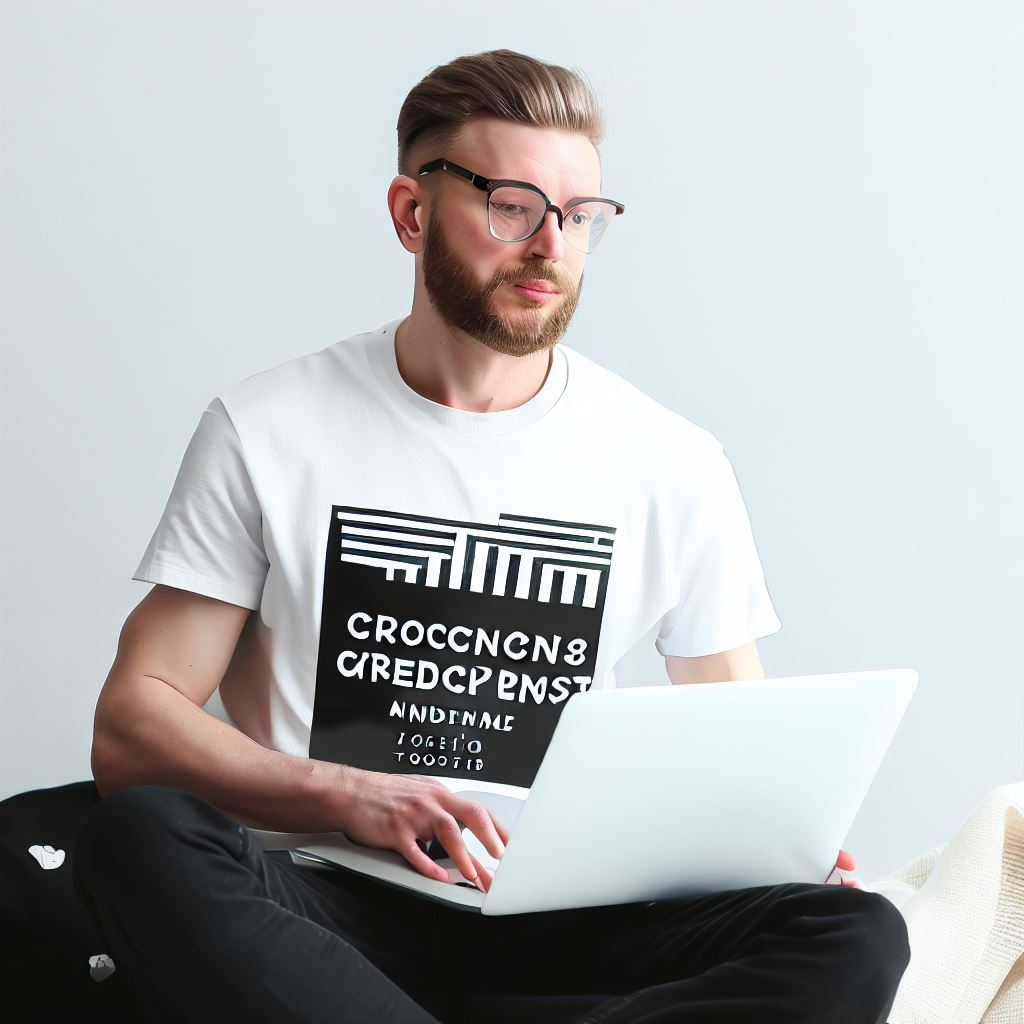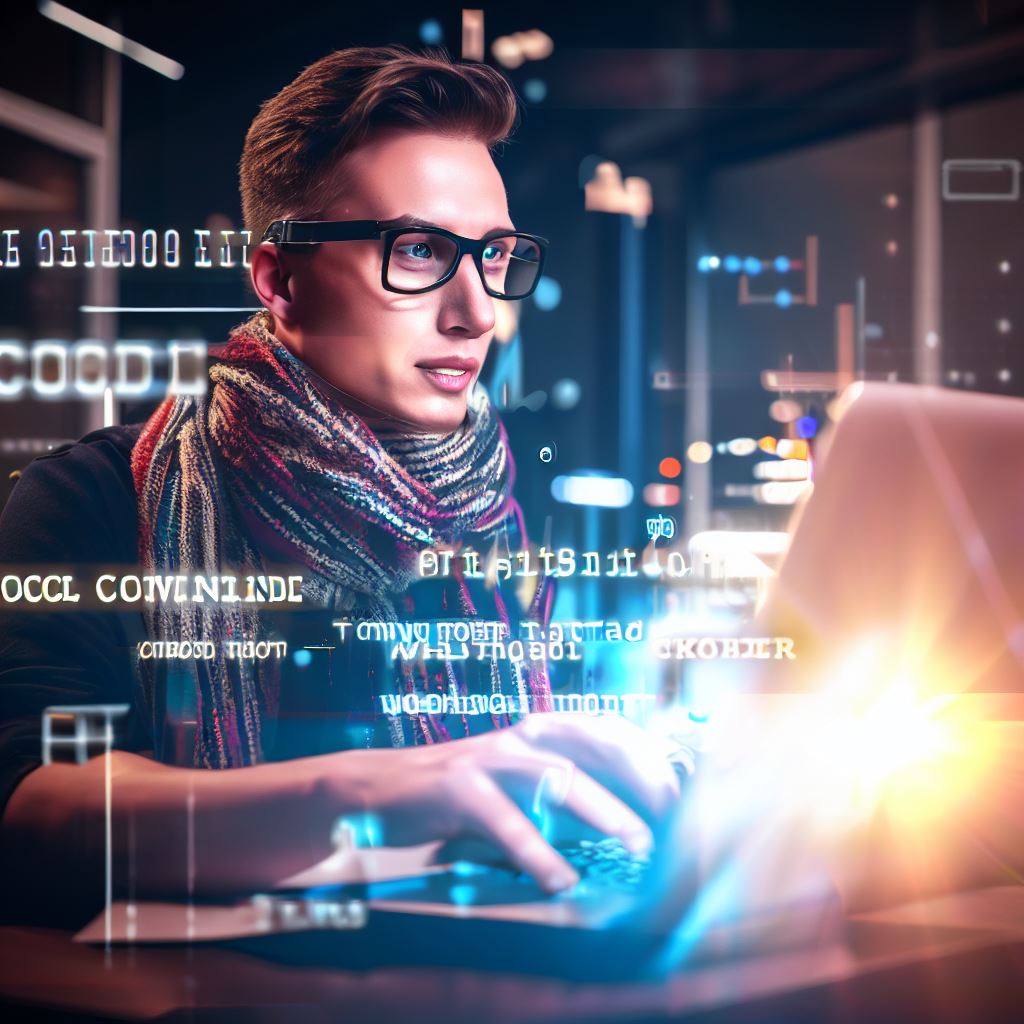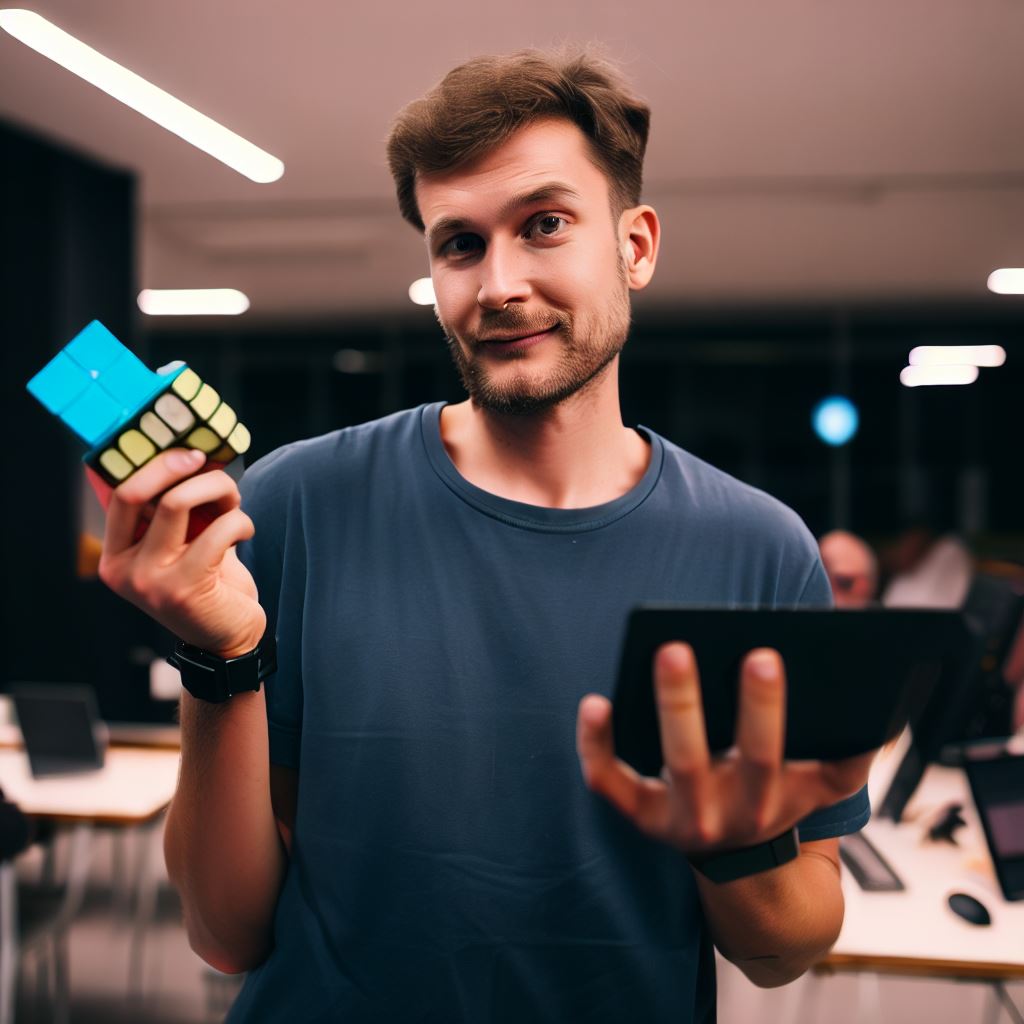Introduction
Coding is the process of creating instructions for a computer to execute.
It is crucial in design as it enables the implementation of ideas into digital platforms or applications.
The importance of coding lies in its ability to bring creativity to life by bridging the gap between imagination and reality.
As technology continues to advance, the intersection of coding and creativity is growing rapidly.
Artists are now utilizing coding as a tool to transform the landscape of U.S. design.
By combining their artistic skills with coding knowledge, artists are able to create interactive and immersive experiences that push the boundaries of traditional design.
These artists are pioneers in their field, utilizing coding languages like HTML, CSS, and JavaScript to create visually captivating and technologically advanced designs.
Their work not only challenges our perception of design but also enhances user experiences by enabling interactivity and personalization.
The use of coding in design allows artists to experiment with different mediums, such as virtual reality, animation, and data visualization.
This interdisciplinary approach not only expands the possibilities of design but also challenges traditional notions of what it means to be an artist.
By embracing coding, artists are able to bring their visions to life in ways that were once unimaginable.
Through their innovative and thought-provoking designs, artists are reshaping U.S. design and paving the way for a new era of creativity.
The Rise of Coding in the Creative Field
A. Historical separation between coding and arts/design
- Coding and arts/design have traditionally been viewed as separate disciplines with little overlap.
- The focus in arts/design was on aesthetics and creativity, while coding was seen as technical and logical.
- The separation between coding and arts/design created a divide in the creative industry.
- Artists and designers were often dependent on developers to bring their visions to life.
- The lack of coding knowledge limited creativity and restricted the possibilities of design.
- There was a misconception that coding was only for software development and not relevant to arts/design.
- This separation hindered collaboration and innovation between artists and coders.
B. Recent shift towards blending coding and creative disciplines
- Advancements in technology and the increasing importance of digital platforms have led to a shift in mindset.
- The demand for interactive and immersive experiences has driven artists and designers to explore coding.
- Artists and designers are now realizing the potential of coding to enhance their creative expressions.
- There is a growing recognition that coding skills can complement and amplify artistic visions.
- Cross-disciplinary collaborations between artists, designers, and coders are becoming more common.
- Coding is being integrated into arts/design education to broaden the skillset of students.
- Artists and designers are seeking to gain coding knowledge to have greater control over their projects.
C. How this fusion has transformed the U.S. design landscape
- The blending of coding and creative disciplines has resulted in groundbreaking and innovative projects.
- Artists and designers are leveraging coding to create interactive installations, digital art, and immersive experiences.
- Technology-driven mediums, such as virtual reality and augmented reality, have gained prominence in the design field.
- Coding has empowered artists and designers to explore new artistic possibilities and push boundaries.
- The integration of coding in design has led to a more holistic approach to problem-solving and creativity.
- Artists and designers are now able to bring their ideas to life independently, without relying solely on developers.
- The U.S. design landscape has become more dynamic and inclusive, encouraging collaboration and interdisciplinary work.
Therefore, the rise of coding in the creative field has revolutionized the relationship between arts/design and technology.
Blending coding with creative disciplines has bridged the historical separation, opening up new avenues for artistic expression and innovation.
The fusion of coding and design has transformed the U.S. design landscape, fostering collaboration, and pushing the boundaries of creativity.
Tech Consulting Tailored to Your Coding Journey
Get expert guidance in coding with a personalized consultation. Receive unique, actionable insights delivered in 1-3 business days.
Get StartedRead: Understanding Coding Syntax: Common Mistakes to Avoid
Examples of Artists Utilizing Coding in Design
A. The diversity of artists adopting coding techniques
- Artists from various backgrounds are embracing coding as a tool to enhance their design process.
- The inclusive nature of coding allows artists of all disciplines to explore new creative possibilities.
B. Case studies of well-known artists and their coding initiatives
1. Casey Reas: Pushing the boundaries of design through coding projects
Casey Reas, known for his co-creation of the influential programming language Processing, has revolutionized U.S. design with his coding initiatives.
Through his project “Process Compendium,” Reas explores the generative possibilities of coding in creating mesmerizing digital art.
By blending algorithms and visual aesthetics, Reas pushes the boundaries of design, inspiring a new generation of artists to experiment with coding.
2. Refik Anadol: Elevating artistic creations through coding skills
Refik Anadol, a prominent Turkish media artist, has harnessed the power of coding to create awe-inspiring immersive experiences.
Through his project “Machine Hallucinations,” Anadol combines architectural spaces with advanced computation, transforming physical environments into mesmerizing visual spectacles.
Anadol’s coding skills have elevated his artistic creations, pushing the boundaries of traditional design.
C. How these artists have successfully integrated coding and design
- By adopting coding techniques, artists can seamlessly merge traditional design elements with technological advancements.
- The integration of coding enables artists to create interactive, dynamic visual experiences for their audience.
- Artists can use coding to manipulate visual elements, generate unique patterns, and create complex compositions.
- Coding allows artists to explore new mediums and push the boundaries of traditional artistic practices.
- By incorporating coding into their design process, artists gain greater control over the final outcome, ensuring their creative vision is fully realized.
Most importantly, the adoption of coding by artists has ushered in a new era of design in the United States.
The diversity of artists embracing coding techniques showcases the inclusiveness and accessibility of this creative tool.
Through specific case studies of artists like Casey Reas and Refik Anadol, it is evident that coding has immense potential for transforming design.
The successful integration of coding and design enables artists to create immersive, interactive, and groundbreaking works of art.
By embracing coding, artists transcend traditional design boundaries, revolutionizing the creative landscape and inspiring future generations of artists.
Read; Unlocking Opportunities: Coding Grants for U.S. Students
Benefits of Coding for Artists and Designers
A. Advantages of Learning Coding for Artists and Designers
- Opens up new possibilities: Learning coding allows artists and designers to expand their skill set and explore new creative avenues.
- Enhanced collaboration: Artists and designers who understand coding can work more seamlessly with developers and programmers.
- Increased control over projects: Knowing how to code empowers artists and designers to bring their visions to life with precision and accuracy.
- Improved problem-solving abilities: Coding promotes analytical thinking and equips artists and designers with the skills to tackle complex design challenges.
- Seamless integration of technology: With coding skills, artists and designers can effortlessly incorporate interactive elements into their work.
- Greater independence: Artists and designers who can code are not reliant on others to bring their ideas to fruition, enhancing their creative autonomy.
- Enhanced understanding of digital tools: Learning coding allows artists and designers to fully comprehend the tools and software they use.
B. How Coding Enhances Creativity and Facilitates Innovative Designs
- Interactive and immersive experiences: Coding enables artists and designers to create dynamic and engaging experiences for their audience.
- Customization and personalization: With coding knowledge, artists and designers can tailor their creations to meet the specific needs and preferences of their clients.
- Experimentation and iteration: Coding empowers artists and designers to quickly prototype and iterate their designs, fostering a culture of innovation.
- Integration of different media: Coding skills enable artists and designers to seamlessly integrate various mediums, such as graphics, audio, and video, in their work.
- Adaptive design: Understanding coding allows artists and designers to create designs that can adapt and respond to users, providing a personalized experience.
- Expressing abstract concepts: Coding provides a medium for artists and designers to express complex and abstract ideas in a visual and interactive manner.
- Pushing creative boundaries: With coding, artists and designers can challenge conventional design norms and explore unconventional artistic expressions.
C. Increased Job Prospects and Versatility Offered by Coding
- In-demand skill: Coding proficiency is highly sought after in the job market, opening up numerous career opportunities for artists and designers.
- Integration of design and technology: Coding allows artists and designers to bridge the gap between design and technology, creating unique value propositions.
- Versatility across industries: Artists and designers with coding skills can work in diverse sectors such as web design, game development, and user experience design.
- Freelancing opportunities: Coding proficiency gives artists and designers the flexibility to work independently and offer their services as freelancers.
- Increased earning potential: Artists and designers who can code often command higher salaries due to their specialized skill set.
- Long-term career growth: The demand for artists and designers who understand coding is expected to increase, providing long-term career prospects.
In short, learning coding offers numerous benefits to artists and designers ranging from expanded creative possibilities to increased job prospects.
Build Your Vision, Perfectly Tailored
Get a custom-built website or application that matches your vision and needs. Stand out from the crowd with a solution designed just for you—professional, scalable, and seamless.
Get StartedIt enhances their ability to collaborate with other professionals, facilitates innovative designs, and opens doors to new career paths.
By embracing coding, artists and designers can unlock their full creative potential and adapt to the evolving digital landscape.
Read: Moms in Tech: Juggling Parenthood and Coding in USA

Challenges and Considerations for Artists Venturing into Coding
A. Common concerns or reservations that artists may have regarding coding
- Artists may worry that coding is too technical and not creative enough.
- There is a fear of not having enough time or energy to learn coding on top of their artistic practice.
- Some artists may feel overwhelmed by the complex terminology and concepts associated with coding.
- There could be concerns about coding taking away from the authenticity and uniqueness of their artistic expression.
B. The learning curve and potential obstacles when getting started with coding
Learning to code can be challenging, but with determination and the right resources, artists can overcome these obstacles:
- Initially, artists may find it difficult to grasp the syntax and logic of coding languages.
- Errors and bugs can be frustrating, and debugging code requires patience and problem-solving skills.
- Keeping up with the rapid pace of technological advancements in coding can be overwhelming.
- Artists may struggle with finding a balance between their art and learning coding, leading to time management challenges.
C. Resources and tips for artists to overcome these challenges
Artists can successfully venture into coding by following these strategies:
- Start with beginner-friendly coding languages like HTML and CSS to build a solid foundation.
- Take advantage of online tutorials, coding bootcamps, and workshops specifically designed for artists.
- Collaborate with other artists who have coding experience to learn and solve coding problems together.
- Join online communities and forums to seek support and guidance from experienced coders.
- Break down coding projects into smaller, manageable tasks to avoid feeling overwhelmed.
- Set aside dedicated time for learning coding, integrating it into the artistic practice gradually.
- Embrace trial and error, understanding that coding is an iterative process that involves debugging and refining.
- Seek inspiration from other artists who have successfully combined coding with their artistic endeavors.
- Keep up with coding news and trends through blogs, podcasts, and online publications.
- Remember that coding can enhance and expand artistic possibilities, allowing for new forms of self-expression.
By addressing concerns, acknowledging the learning curve, and providing valuable resources, artists can confidently venture into coding and transform their creative practice.
Read: Top 5 High-Paying Tech Jobs for New Coders in USA
The Future of Coding and Design in the U.S.
A. Potential Impact of Coding on the Future of U.S. Design Industry
- Coding has the potential to revolutionize the U.S. design industry by enabling new possibilities.
- Artists who incorporate coding skills into their design process can create interactive and dynamic experiences.
- Coding opens up opportunities for designers to collaborate with developers and create innovative solutions.
- As technology continues to advance, coding will become an essential skill for designers to stay relevant.
- Coding empowers designers to bridge the gap between traditional artistic expression and digital media.
B. Emerging Trends and Technologies Shaping Coding for Creatives
- Artificial Intelligence (AI) is transforming coding, allowing designers to automate repetitive tasks and focus on creativity.
- Virtual Reality (VR) and Augmented Reality (AR) are presenting new realms for designers to explore and code immersive experiences.
- Responsive web design and mobile applications are increasing the demand for designers with coding skills.
- Data visualization and information design require coding expertise to communicate complex information effectively.
- Internet of Things (IoT) integration in design creates opportunities to code interactive and connected physical objects.
C. Encouraging Artists to Embrace Coding as an Integral Part of their Creative Process
- Artists should not view coding as a threat to their creativity but rather as a tool to enhance it.
- Learning to code can expand an artist’s skill set and open doors to new career possibilities.
- Coding empowers artists to bring their visions to life in ways that were previously unimaginable.
- Collaborating with other professionals, such as developers, can lead to innovative and groundbreaking projects.
- By embracing coding, artists can stay ahead in the rapidly evolving design industry and remain competitive.
Basically, coding has a significant impact on the future of the U.S. design industry.
By embracing coding skills, artists can unlock new creative possibilities, collaborate with developers, and stay relevant in a rapidly changing technological landscape.
Emerging trends like AI, VR, and IoT are shaping the future of coding for creatives.
It is crucial for artists to see coding as an integral part of their creative process and recognize the opportunities it brings.
By embracing coding, artists can push boundaries, create immersive experiences, and contribute to the transformation of the design industry in the United States.
Conclusion
Coding has revolutionized U.S. design, offering endless creative possibilities to artists and designers.
By incorporating coding into their work, they’ve pushed the boundaries of traditional design, creating interactive and dynamic experiences.
Optimize Your Profile, Get Noticed
Make your resume and LinkedIn stand out to employers with a profile that highlights your technical skills and project experience. Elevate your career with a polished and professional presence.
Get NoticedI encourage artists and designers to embrace coding as a tool for innovation and self-expression.
The fusion of art and technology opens doors to uncharted realms of creativity, captivating audiences and shaping the future.
As coding continues to evolve, it will undoubtedly play an even more integral role in the world of design.
The future promises a harmonious blend of artistic vision and technological prowess, paving the way for unprecedented design innovations.




